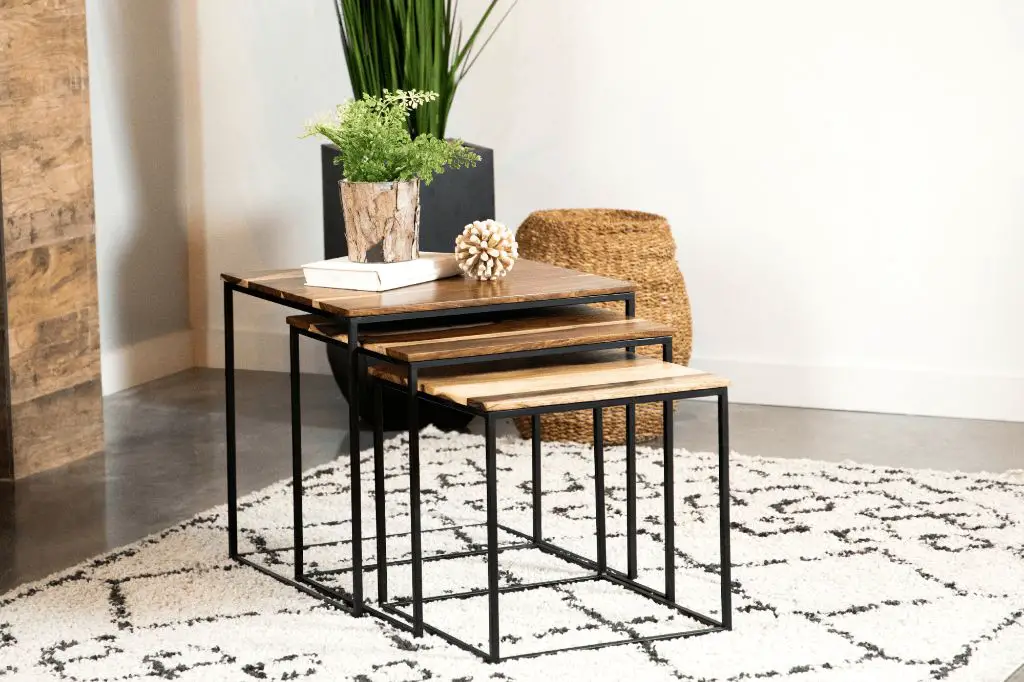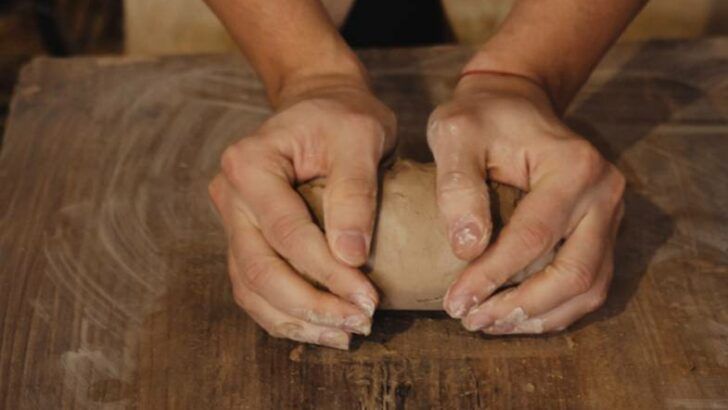What Size Should A Side Table Be?
Side tables are small tables typically placed next to larger pieces of furniture like sofas, chairs, and beds. They serve both a functional and decorative purpose by providing a surface for placing items within arm’s reach while also accenting a room’s style. The ideal size for a side table depends on several factors, including your space, decor, needs, and preferences. This article will discuss how to determine the optimal side table size for your home. It will go over standard dimensions, measuring tips, clearance requirements, functionality, and aesthetic considerations to help you evaluate your options and select the perfect side table.
Factors That Determine Side Table Size
There are several key factors that will determine the ideal size for your side table:
The first is the intended function of the table. Will it mainly be used for storage, like holding books or remotes? Or is it more of a display table for decorative items? The functional needs will impact the dimensions. For example, a table meant for storage should be large enough to neatly organize the intended contents (Rapport Furniture).

You also need to consider the size and layout of the room. Make sure to measure the available floor space to see what will fit without cluttering. Allow enough clearance around the table for traffic flow. A small room calls for a more compact table size (Emily Henderson).
The desired aesthetic is key as well. Do you want a table that seamlessly blends into the decor, or one that makes a bold style statement? Take into account the scale and proportions that will work best for the overall look you want.
Standard Side Table Dimensions
When selecting a side table, it’s helpful to know the standard dimensions for small, medium and large options:
- Small side tables are typically 12-18 inches wide and 12-20 inches deep. They stand 16-26 inches tall. These compact sizes are great for squeezed spaces.
- Medium side tables measure 18-24 inches wide by 18-26 inches deep. Their height ranges from 22-30 inches. This is the most common and versatile side table size.
- Large side tables are 24-36 inches wide and 24-36 inches deep. They are 26-34 inches tall. These spacious tables work well in open floorplans.
According to interior design experts, the ideal side table height ranges between 18-26 inches tall in seated areas like sofas and sectionals. This allows enough space to reach over and set down drinks and remotes comfortably. Near chairs and loungers, aim for 26-34 inches tall for easy access (Source 1).
When browsing options, look for dimensions within these standard size ranges for small, medium and large side tables to find the right fit (Source 2).
Measuring Your Space
When deciding on the right size for a side table, the first step is to accurately measure the area where you plan to place it. Properly measuring the space will ensure the table is well-suited to both the size of the room and its existing furniture.
Begin by measuring the length and width of the area using a tape measure. According to The Home Depot, stand against one wall and extend the tape across the floor to the opposite wall. Be sure to deduct the width of any doorways or openings. For the length, measure from wall to wall. Record these measurements.
Next, measure the height of the space from the floor to the bottom of any overhanging furniture, shelves, or windowsills. This will give you the maximum allowable height for the table. It’s also wise to double check that furnishings already in the space, like a sofa or chair, will accommodate a table beside them without obstructing walkways.
With the room’s dimensions in hand, you’ll be able to shop for a properly sized side table that fits both the footprint and existing decor of the space.
Consider Room Traffic Flow
When choosing the size of a side table, it’s important to consider the traffic flow in the room and make sure the table doesn’t disrupt natural movement patterns. The table should not block doorways or main walking paths. As this guide from Green with Decor recommends, “Make sure there is enough room for people to comfortably move around the space without bumping into furniture or feeling squeezed.”
Try to position the side table out of primary circulation routes. Kate Marker Interiors suggests arranging furniture in relation to traffic flow and notes that “You generally don’t want to disrupt the flow too much by placing furniture in the main thoroughfares.” The ideal side table size will allow smooth, unobstructed movement in the room.
Consider placing the table against a wall or in a corner to keep the middle of the room open. Make sure there is enough clearance around the table so it doesn’t feel like an obstacle. An oversized table can make a room feel cluttered and cramped, while a table that’s too small won’t get in the way.
Allow for Necessary Clearances
When determining the ideal size for your side table, it’s important to leave enough space around the table for accessing any drawers or opening cabinet doors without bumping into nearby furniture. You’ll also want to allow room for lamps, decor items, and other objects typically placed on the table surface. The Emily Henderson design blog recommends allowing at least 18 inches of clearance around all sides of the table.
This means you don’t want your side table crammed right up against the edge of a sofa or chair. Leave some breathing room so that leaning over to open a drawer or access the tabletop doesn’t feel cramped or awkward. The exact amount of clearance needed depends on the size and style of the table. For example, a table with just an open shelf underneath may only need 12-15 inches of clearance, while a cabinet-style table with doors may need the full 18 inches.
When placing your side table near a walkway, allow even more space so people don’t accidentally bump their legs on the table corners as they pass by. It’s always better to err on the side of too much clearance than not enough. Just be sure to measure carefully so you don’t end up with a side table that looks lost or floats awkwardly in the room.
Factor in Your Needs
When selecting a side table, it’s important to consider your functional needs and choose a table that meets them. Think about how you plan to use the table. Do you need surface area to set down drinks, books, remotes, and more? Make sure to choose a tabletop large enough to accommodate your necessary items. According to Studio McGee, you should “ask yourself what function your side table will be performing and factor that into your decision.”
Also consider whether you need enclosed storage or open shelving. For items you want to tuck away like chargers or remotes, choose a table with drawers or cabinets. For decorative objects you want to display, open shelving or a table with a lower shelf may be ideal. As Emily Henderson advises, take into account what you plan to store on or in the table. This will dictate whether drawers, cabinets, or open shelving best suit your needs.
The height of the table is another important factor. Make sure it is in proper proportion to the height of your sofa or chair arm so that items can be easily reached. According to Henderson, a side table should be within 0″-4″ of the furniture arm height to be most functional.
Finally, think about your own needs. If you are taller or shorter than average, adjust the side table height accordingly so it works ergonomically for you when seated. Consider your needs first when selecting a side table size and style.
Aesthetic Considerations
When choosing a side table, you’ll want to select one that complements your existing room decor in terms of style, color, and material. Matching the style of your side table to your overall room can help create a cohesive look. For example, a sleek metal and glass side table would pair well with modern decor, while a distressed wood side table would fit better in a farmhouse-style room.
Selecting a side table in a similar color palette to your room is an easy way to pull everything together visually. Neutral colored side tables like white, black, gray, and wood tones tend to be versatile options that can work with most color schemes. If you want your side table to make more of a statement, choose a bold color that ties into the room’s main accent color.
The material of your side table is another consideration that impacts its aesthetic. Ceramic, glass, metal, and wood surfaces each have distinct visual styles. For a lighter look, try a glass-topped side table. Wood or stone side tables in medium-to-dark stains add warmth. Whatever material you opt for, make sure it complements the existing materials and finishes used in your decor.
When styling your side table, remember that it should work cohesively with the larger decor and design scheme of your room. Select options featuring details, colors, textures, and materials that tie everything together. With some thoughtful coordination, your side table can become an integral part of your room’s overall aesthetic appeal.
Evaluate Your Options
When choosing a side table, you’ll want to consider the pros and cons of different materials and sizes. Some popular materials for side tables include:
- Wood – A classic material, wood side tables can provide a warm, natural look. Pros are durability and style options. Cons are potential scratches and watermarks. See https://www.italianbark.com/how-to-choose-the-right-side-table-for-your-bedroom/ for more information.
- Metal – Metal side tables are modern, chic, and lightweight. Pros are easy to clean and match various decor styles. Cons are potential to show smudges. Refer to https://mixandmatchdesign.com/new-blog/choosing-the-right-side-table-and-lamp-plus-six-no-fail-combos for more details.
- Glass – Glass-topped side tables provide a sleek, transparent look. Pros are an airy feel and easy maintenance. Cons are potential to scratch or show fingerprints. Check https://happyhourprojects.com/side-table/ for an overview.
When it comes to size, a standard side table is around 20-28 inches tall. However, consider your needs and space:
- Smaller tables (15-20 inches tall) work for tight spaces. Good for holding just a lamp.
- Medium tables (20-25 inches) are versatile for many uses. Standard size for most needs.
- Larger tables (25-28+ inches) provide ample surface area. Great for large bedrooms.
Evaluate your room size, bed height, layout, and intended uses for the side table when deciding on material and size.
Conclusion
In conclusion, determining the ideal size for your side table requires balancing several factors. The standard dimensions for side tables tend to range from 18-24 inches wide and 16-28 inches high. However, the optimal size depends on the room you’re placing it in, your space constraints, necessary clearances, aesthetic preferences, and functional needs.
When deciding on a side table, measure the area you intend to place it and ensure it allows for proper traffic flow. Be sure to account for ample leg room and any other required clearances. Consider your planned uses for the table, like reading, drinks, décor, etc. Evaluate different size options to find one that fits the space appropriately and meets your needs.
In general, a side table around 20 inches wide by 24 inches high can work well in many living spaces. But take time to think through your specific goals, spatial constraints, and style preferences to determine the ideal side table size for your room.



